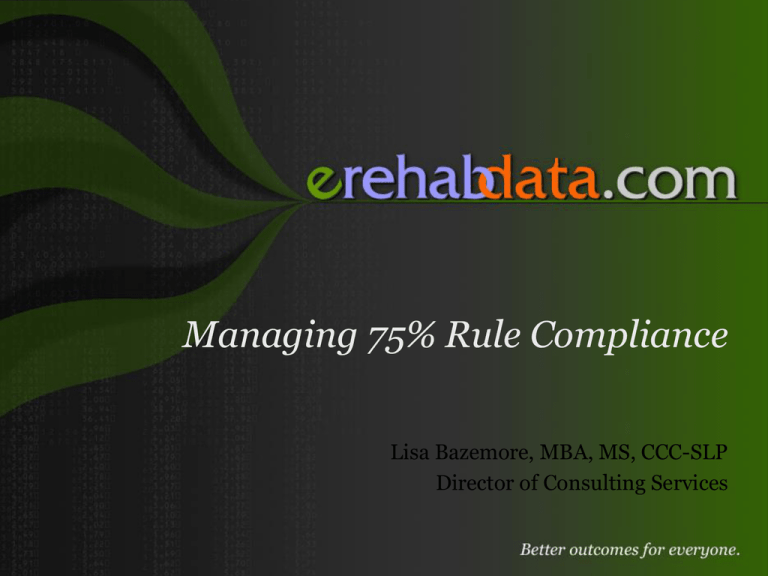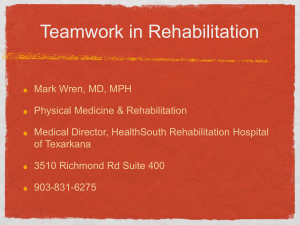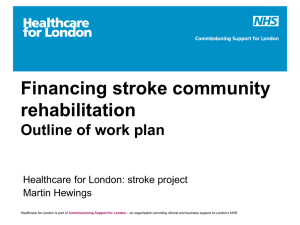75_percent_rule
advertisement

Managing 75% Rule Compliance Lisa Bazemore, MBA, MS, CCC-SLP Director of Consulting Services Learning Objectives • As a result of this session, the learner will: Have new strategies for identifying patients that are 75% rule compliant Know what documentation needs to be in place for qualifying a patient as 75% rule compliant Be able to analyze reports and sleep well at night knowing that you are operating within compliance Identifying Opportunities Basic principles in identifying opportunities are: • Determining who we are looking for • Knowing where to find them • Documenting to substantiate their admission Who are we looking for? • Patients that presumptively qualify by Rehab Impairment Category • Patients that presumptively qualify by etiologic diagnosis • Patients that presumptively qualify by co-morbidities • Patients that meet the conditions of compliance for arthritis conditions Who are we looking for? • IGC qualification beyond the obvious: Non-traumatic spinal cord injury • Is there documentation in the acute or rehab chart to support lower extremity weakness, myopathy, myelopathy, neurogenic bladder? • Has your Medical Director examined the patient for these conditions? Arthritis • Don’t forget to look for documentation of active treatment of a systemic condition. • Look at the MAR. If the reason for pharmacological treatment is not stated, ask for more specific documentation for the need for an arthritis medication. Multiple Fractures with Trauma • If a patient sustained multiple fractures, is there mention of further organ damage or systems trauma? • Review physician documentation, radiology reports, labs for signs of further involvement. Who are we looking for? • Etiologic diagnosis and co-morbidities beyond the obvious: Stroke: • Late effects CVA can qualify a patient if there is documented evidence that we are bringing the patient in to treat that condition. Further, they must require rehab for that condition in the absence of the admitting impairment group. • When does this occur? When a patient’s symptoms are exacerbated by the admitting condition that results in decreased function. Brain Injury: • Late effects from a traumatic or non-traumatic condition may meet the same conditions as noted above for stroke. Who are we looking for? • Etiologic diagnosis and co-morbidities beyond the obvious: Neurological conditions: • Parkinson’s may qualify a patient when there is evidence of active treatment of the condition by the physician and therapists. • Polyneuropathy is a condition that qualifies a patient in certain situations. Look at the documentation in the chart. If there isn’t enough evidence to tell the origin of the neuropathy, request more specific documentation of the condition. • Critical Illness Myopathy is a common condition seen in patients that have long stays in the ICU. If not documented, ask for further diagnostics to determine if this condition exists. Arthritis as a comorbidity: • If a patient requires rehab for any condition other than a joint replacement, qualifying arthritis as an active comorbidity still requires conditional compliance. • This means that arthritis must be actively treated and the patient would have needed IRF level of care for arthritis in the absence of the RIC condition. • Further evidence of prior, failed therapy and joint deformity… Who are we looking for? • Etiologic diagnosis and co-morbidities beyond the obvious: Pelvic Fractures: • Be sure that documentation is very specific as to the point of fracture and the type of fracture. • Look at radiology reports and physician documentation. If they do not match, ask for clarification. Multiple Fractures: • Coders will code the individual fractures, but we follow the instructions in the IRF-PAI Manual for assigning an etiologic diagnosis. That allows the program to assign a code not necessarily provided by the coding team. • Utilize codes 828.0, 828.1, 819.0, 819.1 where applicable. These codes are presumptively compliant. The individual fractures can be included as co-morbidities. How do we find them? • Pre-Admission Screening Don’t be afraid to ask for more information Look at all acute documentation for consistency • • • • • Physician documentation Nursing and therapy notes MARs Radiology reports Labs Know the presumptively compliant conditions so you can be on the look-out Ask questions Request diagnostic evidence as needed How do we find them? • During the Rehabilitation Stay Never stop looking for compliant conditions Educate your Medical Directors and consulting physicians on presumptively and conditionally compliant diagnoses Ask questions during Team Conference/Patient Staffing Communicate with coders Review the assigned codes and ask questions of the coders and staff if codes do not reflect reported conditions Report the codes properly on the IRF-PAI How do we find them? • Tools: Do you know what your hospital census is? Look at the census report daily for: • Patients with a rehab diagnosis • Medicare patients with a length of stay greater than 3 days Meet with case managers and med/surg therapists to identify patients in need of rehab Follow-up on patients that came to your ER and were transferred elsewhere Follow-up on patients sent to SNF or TCU because they were not able to tolerate 3-hours of therapy. Are they ready now? Know your utilization percentage! MedPar and Solucient provide diagnostic breakdowns of patients seen in your hospital. What percent of each RIC are you capturing? What does the paper trail look like? • Qualifying by RIC: Pre-Admission Screening outlines the need for an inpatient rehabilitation stay Physician H&P states the rehab impairment condition Therapy and nursing evaluations substantiate the physician’s exam Ongoing documentation addresses the condition and progress being made • Qualifying by etiologic diagnosis or co-morbid condition: Acute chart identifies the condition as being actively treated Pre-Admission Screening identifies the condition and justifies the need for inpatient rehabilitation Physician documentation identifies the condition at admission Therapy and nursing evaluations also identify the patient’s limitations secondary to the condition Ongoing documentation addresses the condition and progress being made What does the paper trail look like? • Qualifies based on a condition identified during the IRF stay: Physician diagnoses the condition Coders include the condition on the coding sheet Therapists documents treatment of the condition and/or its impact on the course of rehabilitation Nursing documents treatment of the condition and/or its impact on the course of rehabilitation Common trap: Physician documents the condition, but therapy and nursing do not or vice versa What does the paper trail look like? • Coding is the key! What does your coding process look like? • Best practice-coders are coding the chart concurrently • Most common-coders code after the first 3-days and following discharge What does that mean for you? • The responsibility lies with the program manager to ensure that there are no surprises with any patients admitted • Assign someone to review the charts concurrently for evidence of documentation to support the RIC, etiologic diagnosis, and comorbidities • That person should participate in team conferences and other patient care meetings to listen for complicating conditions Who is reviewing the final IRF-PAI before transmission? • Do all codes reflect the patient you treated? • Are all codes in the proper place on the IRF-PAI? • Are there lessons learned about conditions that were coded differently than suspected? Remember to educate for the next time. Analyzing the compliance reports • How do you know what your 75% rule compliance really is? Track all admissions Know how you will report your compliance to the FI: admissions or discharge Confirm the final IRF-PAI with the patient’s status on the compliance report • On the report, your compliance percentage shows presumptive and conditional compliance by payor type. • In order to appear on this report correctly, you will answer questions on the eRD tab to determine if the patient is 75% compliant or not. Are the patients entered correctly? • Review the detailed assessment to determine what makes the patient compliant. Is the selected reason on the report right? Analyzing the compliance reports • Review the reports for potential entry errors: Does the IGC match the etiologic? • Example: 8.51 unilateral hip replacement with 435.9 transient cerebellar ischemia non-specified Do all patients listed as 75% compliant meet the conditions of eligibility? • Example: Is there adequate documentation to prove that a sustained course of OP therapy for the condition was provided within 20 day of the IRF admission? • Example: Does the active co-morbidity conclusively show the necessity for rehab in the absence of the admitting condition? Are patients with co-morbidities found to make them compliant following admission represented properly? • Example: An accurate BMI is taken that shows the patient to have a BMI>50 while on the unit Operationalizing compliance • What is a safe percentage to maintain? Provided that each patient is properly identified on your 75% report, the compliance threshold established for your current reporting period is adequate. Every patient that meets the criteria for inpatient rehabilitation deserves to receive that level of care. Therefore, operating at a higher compliance while beds are empty is essentially denying a patient an opportunity to regain independence. The key is to be sure that you capture the 75% status of each patient correctly. Operationalizing compliance • Marketing strategies: Maximize internal case finding Develop a system for capturing weekend, after hours, and holiday referrals and admissions-Be accessible Follow ER outmigration Utilize graduated therapy appropriately Follow TCU/SNF admissions that have potential to work up to an IRF level of care Develop a target list of discharge planners, case managers, and therapists at each facility that you visit. Be consistent in your visits and message. Market directly to physicians Market to home care agencies Operationalizing compliance • Keep your marketer in the know Be sure that all screeners know your current compliance threshold Screeners should be prepared to provide a fast turn around on admission decisions That requires access to the program director and medical director for admission decision making Advocate for the patient. Everyone deserves the best possible care, so our goal should be to leave no stone unturned when looking for compliant conditions. Questions?





